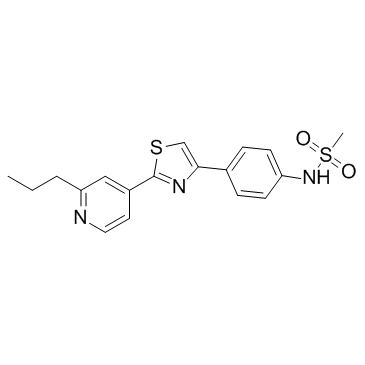| Description |
FGH10019 is a novel sterol regulatory element-binding protein (SREBP) inhibitor with IC50 of 1 μM.
|
| Related Catalog |
|
| Target |
IC50: 1 μM (SREBP)
|
| In Vitro |
Treatment of the CHO-K1 cells with analog FGH10019 decreases the percentage of the mature form of SREBP-2 (68 kDa) at lower concentrations than treatment with fatostatin. Densitometric analysis of the gels indicates that the IC50 of analog FGH10019 is approximately 1 μM, which is 5-10 times lower than the IC50 of fatostatin (appr 10 μM)[1].
|
| In Vivo |
FGH10019-treated chow is fed at a dose rate calculated to provide about 0.7 mg analog FGH10019 per day, at about 23 mg/kg body weight, to 5-wk-old male ob/ob mice weighing an average of appr 30 g. After 8 wk on the analog 24-treated chow, the mice gain 8-9 % less weight than control mice[1].
|
| Animal Admin |
Five-week-old homozygous male obese (ob/ob) mice (C57BL/6J) are housed five per cage, and had ad libitum access to normal chow and water for 1 wk after their arrival. On day 1 of the experiment, the animals (10 per group) are fed normal chow (control diet) or chow that contains 200 mg/kg of analogue 24. These doses are estimated to provide approximately 0.7 mg analogue 24 per day (appr 23 mg/kg body weight per day). Daily food intake and body weight are carefully monitored and recorded between 3:00 and 5:00 p.m. Serum constituents, and TG levels in livers are determined.
|
| References |
[1]. Kamisuki S, et al. Synthesis and evaluation of diarylthiazole derivatives that inhibit activation of sterol regulatory element-binding proteins. J Med Chem. 2011 Jul 14;54(13):4923-7.
|
